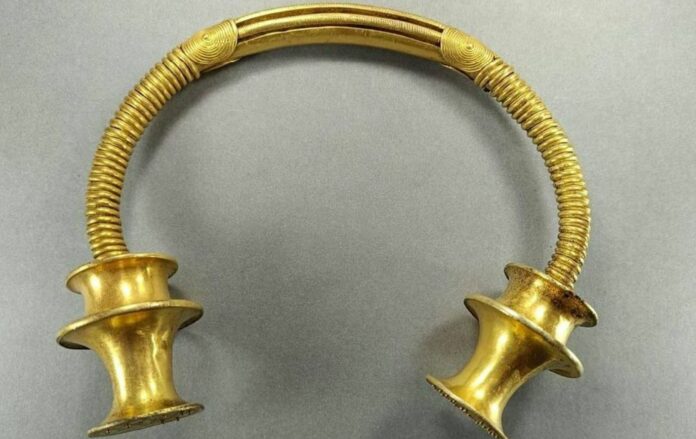Iron Age Gold Necklaces Resurface after Landslide in Spain
In a surprising turn of events in northern Spain, nature has revealed a piece of history. Following a landslide, two ornately detailed gold necklaces, believed to be from the Iron Age, have resurfaced after being hidden underground for approximately 2,500 years.
Sergio Narciandi, an employee from a water provision company on a mission to identify water sources in Peñamellera Baja, Asturias, chanced upon the first crescent-shaped necklace. Pablo Arias, a distinguished archaeology professor at the University of Cantabria, later confirmed to Live Science the significance of the discovery.
After local wildfires resulted in minor landslides pushing soil towards a spring, the gleaming relic was revealed to Narciandi on August 29. Soon after Narciandi’s discovery reached Arias, a team of archaeologists and representatives from the Asturias Archaeological Museum gathered at the site. Their diligent search led to another serendipitous find: fragments of another necklace, with the assistance of metal detector experts to pinpoint the remnants.
Preliminary assessments, grounded in craftsmanship and design, suggest that these jewelry pieces hail from 500 B.C., a timeline that corresponds to the Iberian Iron Age, as reported by El País, a Spanish media house.
Evidence of wear on these golden artifacts suggests they were adorned by society’s elite, as highlighted by CNN.
These substantial neckpieces, termed ‘torques’ or ‘torcs’, derive their name from the Latin verb “torqueo”, translating to “to twist”. This not only illustrates their intrinsic design but also sheds light on their intricate creation method. Existing records indicate the discovery of analogous gold torques on the Iberian Peninsula, some weighing more than 2.2 pounds. However, the exact weight of these newly discovered pieces remains undisclosed, though stylistic similarities have been observed.
Historical experts speculate that these torques might have been products of Celtic artisans who fashioned them using central rods wrapped in golden spirals.
Pablo Arias opined via email that these necklaces were perhaps purposefully hidden, a common practice in Atlantic Europe during the Bronze and Iron Ages.
He hypothesizes that these treasures were either concealed in a cavity or possibly in a now-decomposed organic container. Current efforts include analyzing soil samples to discern potential residues of such containers.
Image Credit: One of the torcs found in Asturias – PRINCIPALITY OF ASTURIAS
